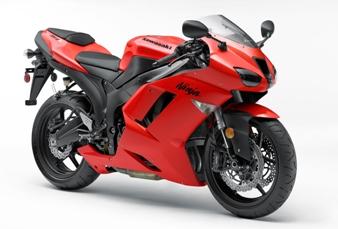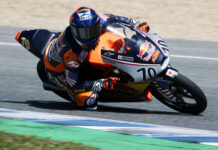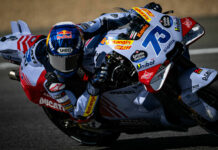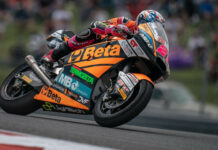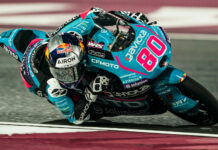Designed to place its rider on the top step of the podium, the new Ninja ZX-6R sportbike elevates 600-class power and handling to the next level. Considering the stellar capabilities of last year’s ZX-6R, Kawasaki’s designers knew it would take a special combination of middleweight power and nimble handling characteristics if they were to make the next leap in middleweight performance. To hone the incredible new machine into an exciting racetrack weapon, Kawasaki appointed a former 125cc Grand Prix racer as the ZX-6R’s chief development rider. The result is an all-new 600 capable of cornering speeds previously unknown to the middleweight class while retaining the wide spread of power that is pure Ninja. To be quickest around the racetrack a motorcycle requires a wide powerband and plenty of over-rev. The ZX-6R’s all-new engine was redesigned from the crankcase up for the first time in ten years, leading to an ultra-high-rpm powerplant that produces more mid-range torque than any of its predecessors. The result is a fat powerband with a linear torque curve for hard-hitting acceleration across the entire rev range. The Ninja ZX-6R’s impressive over-rev capability mimics a true race bike, allowing riders to stay on the gas where lower-revving machines are forced to shift. The Ninja ZX-6R’s all-new engine was also specially designed to reduce internal friction. That’s because low-friction engines tend to be more responsive, making it easier for the rider to modify cornering lines with minor throttle adjustments. The new engine components were also made stronger, stiffer and more compact, resulting in an engine which is about 40mm smaller in both width and length than its predecessors. This compact engine allowed the chassis designers to create a slim and compact chassis. Other racing technology includes a close-ratio cassette transmission that makes it easy to keep the Ninja ZX-6R screaming at its horsepower peak and a slipper clutch which allows quicker downshifts without upsetting the rest of the chassis. In designing the Ninja ZX-6R’s chassis, the development team concentrated on creating a motorcycle that would make fast entry and mid-corner speeds feel easy. A compact, lightweight design allows it to maintain more cornering speed throughout the turn while entry speeds are enhanced by the slipper clutch and powerful radial-mounted front brake calipers. Complementing this track-biased package are fully-adjustable front and rear suspension units. The entire package of frame, suspension, engine and bodywork was designed to enhance the ZX-6R’s fun-to-ride factor by offering a more exciting ride. The results are faster cornering speeds, quicker lap times and even more worried looks on the competition’s faces. The frame and swingarm were developed with an optimized balance of rigidity, so the Ninja ZX-6R responds instantly and precisely to the rider’s every command. Mass centralization, engine mount locations and a variety of other factors were optimized to help ensure instant turn-in characteristics. Once in the turn, the Ninja ZX-6R holds a line with precision and tracks through the apex as if it were on rails. All these features mean chassis feedback is very precise, with the ZX-6R communicating every move directly to the rider. The machine responds more precisely and predictably to control inputs and shifts in body weight. The result is a motorcycle that makes the rider feel like a part of the machine. The new Ninja ZX-6R offers the power of a high-performance 600 Supersport racer mated with the nimble handling characteristics of a small-displacement GP machine. Let the competition compromise performance for rider-friendliness; the new ZX-6R was designed to take home trophies and set the quickest lap times, while being more exciting to ride than anything else in the middleweight sportbike category. Features and Benefits High-Revving 599cc Four-Cylinder, DOHC Engine − New compact, narrow and lightweight design features a tri-axis crankshaft and transmission shaft layout to optimize the engine’s center of gravity. This helps reduce pitch changes during heavy braking and gives the rider more-accurate feedback from the chassis − Narrow engine design allows excellent ground clearance Four-Valve Cylinder Head − Compact valve train reduces cylinder head height − Intake ports and coolant passages were developed using flow analysis for efficient cylinder filling, more power, and maximum cooling efficiency − Forged sintered aluminum spring retainers are half the weight of steel retainers and allow higher rpm Forged Pistons − Forged pistons are lighter, stronger and more heat resistant than cast versions. Ram Air Induction − Central ram air duct produces a straighter path to the airbox for maximum intake efficiency and provides the mounting surface for the instrument panel, eliminating brackets and weight − Flow analysis used to design efficient ducts to the airbox that also prevent water from reaching the air filter − Compact airbox and air cleaner are highly efficient and contribute to the compact riding position Digital Fuel Injection − Shorter throttle bodies deliver improved over-rev characteristics − Smaller throttle bore diameter helps produce more torque in the mid-range − Ultra-fine atomizing injectors improve combustion efficiency, for better power output and lower fuel consumption TCBI Ignition with Digital Advance − High-speed 32-bit ECU processor provides precise engine management − Spark plug-mounted ignition coils are compact and help reduce weight Pre-chamber Equipped Under-seat Muffler − New exhaust pre-chamber is located below the engine and contributes to better mass centralization − Revised under-seat silencer is significantly smaller and lighter to help mass centralization and allow for a more aerodynamic tailsection − New exhaust header design contributes to improved exhaust efficiency Six-Speed Transmission − New cassette-type transmission features a racing-style gear stack to allow easier trackside ratio changes − Close ratio transmission increases circuit performance Racing-Style Slipper Clutch − Racing-type slipper clutch reduces chassis disturbance when making rapid downshifts. This allows the rider dedicate more attention to braking and setting up for the corner − Optional springs, spring retainers and shims are available to fine-tune the clutch for specific track conditions Gear Position Sensor − The convenient gear position sensor gives instant information to the rider, this is especially useful for improving consistency when testing new settings on the racetrack − The system compatible with the semi-automatic shifters (legal in AMA Supersport racing) which temporarily cut ignition to facilitate clutchless shifts at full-throttle Lightweight Twin Spar Aluminum Perimeter Frame − Combination of pressed and cast aluminum components are welded to form the twin-spar perimeter-type frame. By combining cast and pressed pieces frame weight is kept to a minimum while still providing high strength and stability for responsive handling − Chassis features optimum center of gravity for easy roll response, this is particularly important when riding through a series of esses or returning to vertical as the rider exits a corner Uni-Trak® Rear Suspension − New Uni-Trak® rear suspension system features pillow ball upper mount in place of the earlier bushings for a more direct feel and improved feedback − Compact frame and engine allow a longer swingarm, which makes it easier to control rear wheel powerslides − Rear shock is fully adjustable for preload, compression and rebound damping. Ride height can be adjusted by adding/removing optional 1mm shims at the upper shock mount − Equipped with a top-out spring which improves the rear wheel’s ability to follow the road surface when the rear end is light due to hard braking − Small piggyback shock reservoir is designed to save weight 41mm Inverted Cartridge Front Fork − New fully-adjustable 41mm inverted cartridge fork provides exceptional rigidity − Equipped with top-out springs which allow the front wheel to better follow the road surface when the front end is light due to hard acceleration − The main fork spring is located at the bottom of the fork. Because the spring is completely submerged in oil, cavitation is minimized, resulting in stable suspension performance even under demanding racetrack conditions − Stiff settings are suitable for track use
Kawasaki Says New ZX-6R Designed To Flick Like A 125cc GP Racebike
Kawasaki Says New ZX-6R Designed To Flick Like A 125cc GP Racebike
© 2006, Roadracing World Publishing, Inc.
